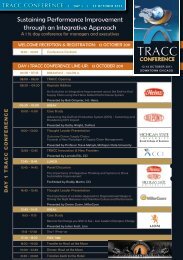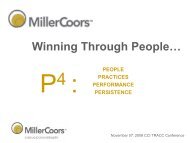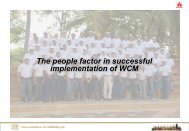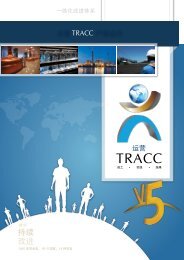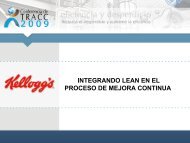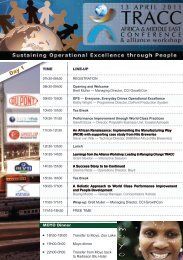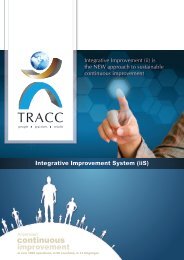Strategy - TRACC
Strategy - TRACC
Strategy - TRACC
- No tags were found...
You also want an ePaper? Increase the reach of your titles
YUMPU automatically turns print PDFs into web optimized ePapers that Google loves.
LEAPFROG YOUR WAY TO WORLD CLASS - <strong>Strategy</strong>• Expert-basedThe focus of these companies is to minimise operations’ potential negative impactto the business. Internal financial control systems are the primary means for monitoringoperational performance. External experts (corporate staff or consultants) are used fordecisions on strategic operational issues and do CI at the sites. The experts have avision of where they want to go from previous implementation experience and aplan for how to get there. They’re often functional (maintenance, quality system, etc) ormethodology-based (Lean, etc). Different experts often have diverse end state visionsas well as different road maps for how to reach the end state. At this stage, CI is projectbasedand takes place mostly in the manufacturing sites. There is no standard CIapproach across sites. The transformation process and competency developmentrequirements for the organisation are neither documented nor understood.• Functional excellenceCompanies at this stage follow industry practice and seek competitor parity. Theplanning horizon for investment decisions is generally within one single businesscycle only. Capital investment often is regarded as the primary means for catching up tocompetition or achieving competitive edge.Companies at this stage (Stage 3) identify their critical systems, which depend on theindustry. (For example, the airline and chemical industries require fail-proofmaintenance systems. The consequences of failure in these critical systems areusually dire, with potential loss of life.) At this stage, these companies wouldhave pushed the evolution of their critical systems, codifying and standardising therequired system elements to ensure that all sites comply. A standard CI approach mightalso have been adopted to follow competitors’ approaches. The functional CI initiativesand adopted standard CI methodology are integrated but are not on the sameplatform. Competency development requirements within functions are understood,but there is no cross-functional visibility. Improvements are functional rather thanprocess-based. The standard approachesadopted have been translated to allow sitesin all geographies to comply. At this stage,most of the formal CI processes are stillin manufacturing.• Integrative improvement systemCompanies at this stage (Stage 4) aremanaging their internal operations as a meansto obtain competitive advantage. Operationalinvestments are screened for consistencywith the business strategy. Business strategychanges are translated automatically intooperational implications. Manufacturing is keyto major marketing and engineering decisions.Long-range initiatives (for example, culturebasedchange programmes) are pursued toacquire capabilities in advance of needs.These companies have evolved to a completemanagement system and have documentedbest practice requirements across all theirfunctional systems with accompanying roadmaps for the sites to close gaps with adiagnostic tool that measures current status.They have incorporated all CI methodologiesinto a shared platform with the functionalimprovement methodologies. At this stage,CI is process-based and the entire organisationis engaged in improvements across thesupply chain. While the incremental approachto the required organisational transformationis documented, the competency acquisitionprocess to move towards multifunctionalteams that optimise processes and valuestreams is driven by a documented andintegrated road map.The management system with implementationdetail and training programmes is availableWGLL Journal Volume 2 © CCI info@etracc.net www.etracc.net



